Our rainy spring weather has been great for our gardens – but may also have encouraged some unwelcome garden visitors, including snails and slugs.
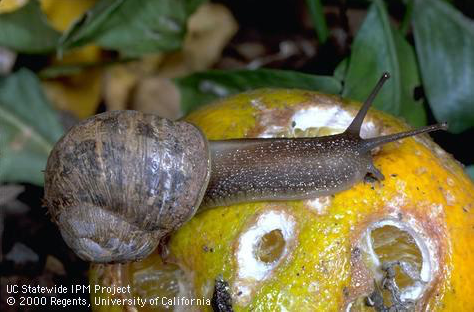
To control snails, slugs and other pests, the University of California recommends that homeowners follow the Integrated Pest Management (IPM) process. IPM is a strategy that focuses on long-term prevention of pests by utilizing cultural, biological, mechanical and physical controls. With IPM, pesticides (chemical control) are used only as a last resort, and when pesticides are used, they are applied in ways that minimize harm to nontarget organisms, humans, pets, and the environment.
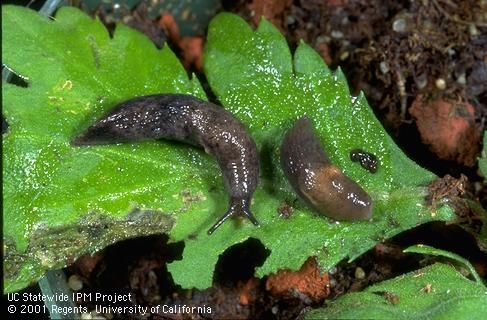
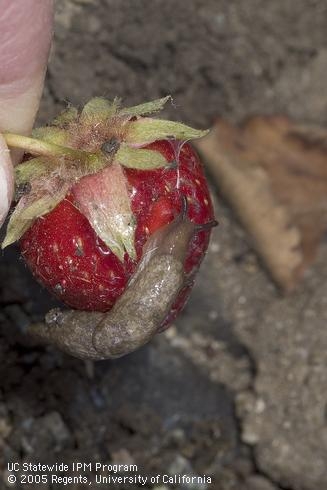
Mechanical or physical controls kill a pest directly or block a pest from an area experiencing damage. In the case of snails and slugs, handpicking is an effective mechanical control if it is done on a regular basis. They can be searched out after dark with a flashlight and then either crushed in place or picked up with rubber gloves. Once they have been picked up, they can be placed in a bag and thrown away in the trash, or placed in a bucket of soapy water and disposed of in a compost pile after they are dead. Alternatively, if you are lucky enough to know someone with pet turtles, you can give your snails and slugs to them (as long as they are healthy) -- most turtle owners are happy to receive these pests, which add protein to the turtle diet. Those with backyard chickens may be similarly appreciative, as chickens, too, eat snails.
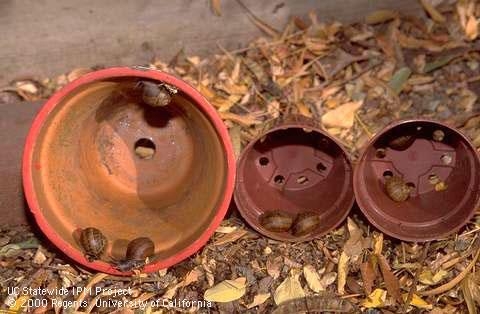
Copper flashing or copper foil can be used as a physical barrier for slugs and snails. It is believed that copper is an effective barrier because it reacts with the slime of these pests, causing a disruption in their nervous system that is similar to an electric shock. These barriers should be at least four inches wide with the bottom buried in the soil to prevent slugs from crawling under them. Dry ashes or other abrasives such as diatomaceous earth can also be used as barriers for slugs and snails. Such abrasives should be piled about one inch high and 3 inches wide to be effective. However, these materials lose their deterrent value if they become damp, making them not very useful in most garden situations. Another drawback of wood ashes is that they are quite alkaline and can have a detrimental effect on soil pH.
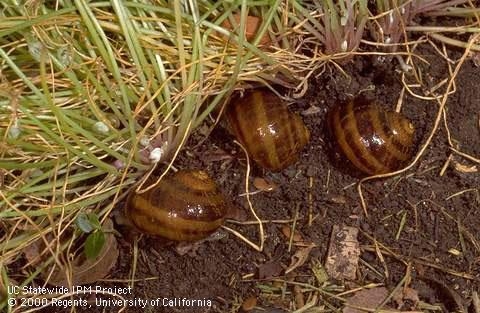
Slug and snail baits can be applied as a last resort, but are most effective if used in conjunction with the IPM methods described above. There are other effective baits, but baits containing iron phosphate are the only ones that are safe for children, domestic animals, birds, fish and other wildlife. Iron phosphate baits are sold under many trade names including Sluggo and Escar-Go. The bait should be placed in moist areas that snails or slugs are likely to frequent. Timing is also important. If the weather is very hot, dry, or cold, baiting will have a limited effectiveness because slugs and snails are least active during these times. Take advantage of snail and slug habits by irrigating before baiting and scattering the bait in the late afternoon or evening.
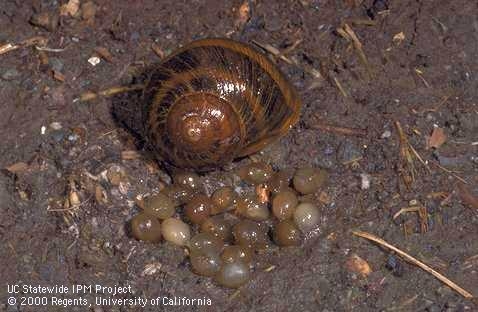
UC Master Gardeners of Butte County are part of the University of California Cooperative Extension (UCCE) system. To learn more about us and our upcoming events, and for help with gardening in our area visit our website. If you have a gardening question or problem, email the Hotline at mgbutte@ucanr.edu or leave a phone message on our Hotline at 530-552-5812. To speak to a Master Gardener about a gardening issue, or to drop by the MG office during Hotline hours, see the most current information on our Ask Us section of our website.
- Author: Brent McGhie
By Brent McGhie, UC Master Gardener of Butte County, May 31, 2019
The University of California recommends the use of Integrated Pest Management (IPM) to control garden pests. The goal of IPM is to use the least harmful control method(s) that will be effective in managing a particular pest. Depending on the pest, these methods include one or more of the following: cultural controls, biological controls, mechanical and physical controls and chemical controls (pesticides). When using IPM, it is recommended that gardeners resort to the use of pesticides only as a last resort, after other control methods have been tried and found wanting.
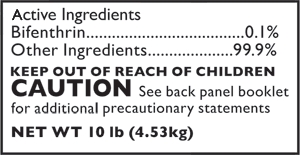
Once the decision to use a pesticide has been made, the next step is to choose the right pesticide. The University of California Pest Notes series is a good source of information for identifying the least toxic pesticides appropriate for a specific pest. Low toxicity pesticides include insecticidal oils and soaps as well as the microbial insecticide, Bacillus thuringiensis, which is effective against many caterpillars, but nontoxic to other animal life. Pest Notes are available from your local UC Master Gardener program (based at the UC Cooperative Extension Office) and online at the UC Statewide IPM Program website.

Whenever a pesticide is used, all instructions should be read and carefully followed. Especially critical are instructions concerning proper application and safety precautions (for example, the use of protective clothing and eyewear).
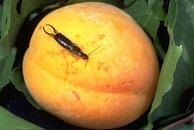
The only legal way to dispose of pesticides is to take them to a local hazardous waste disposal facility. Do not pour unused or excess material down the drain, onto the soil, into waterways, into gutters, or into the trash. However, in California it is legal for homeowners to dispose of empty pesticide containers in the trash. Before disposing, containers should be triple rinsed and the rinse water used as part of the last application. To find the location of the closest hazardous waste disposal site, call the California Environmental Hotline (1-800-253-2687), or visit the “Earth911” website.
Information in this article is based on “Pesticides: Safe and Effective Use in the Home and Landscape” from the UC IPM website (Pest Note #74126).
For more information on gardening in our area, visit the UC Master Gardener of Butte County webpage at: http://ucanr.edu/sites/bcmg/. If you have a gardening question or problem, call our Hotline at (530) 538-7201 or email mgbutte@ucanr.edu.
By Brent McGhie, Butte Coounty Master Gardener, April 21, 2017.
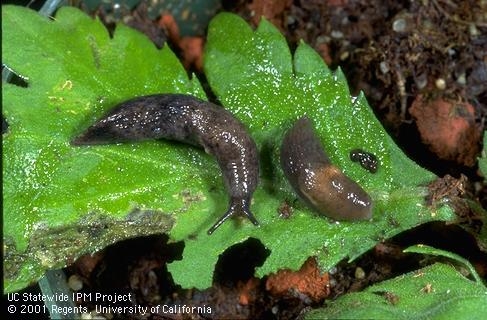
To control snails, slugs and other pests, the University of California recommends that homeowners follow the Integrated Pest Management (IPM) process. IPM is a strategy that focuses on long-term prevention of pests by utilizing cultural, biological, mechanical and physical controls. With IPM, pesticides (chemical control) are used only as a last resort, and when pesticides are used, they are applied in ways that minimize harm to nontarget organisms, humans, pets, and the environment.
Cultural controls involve manipulating the environment to make an area less hospitable for a pest. In the case of snails and slugs, a good first step is to eliminate places they can hide during the day. Such hiding places include boards, stones, debris, weedy areas around tree trunks, leafy branches close to the ground and dense ground covers. If hiding places can't be eliminated, vegetable gardens and susceptible plants should be located as far from them as possible. Switching from sprinklers or flood irrigation to drip irrigation will also make the habitat less desirable for snails and slugs by reducing the humidity and moist surfaces they prefer.
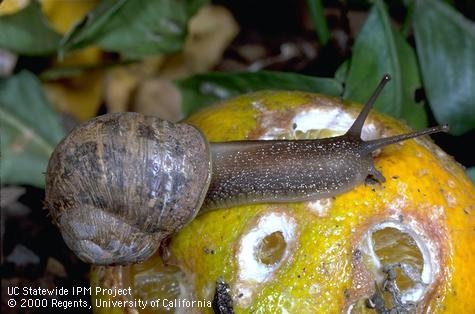
Mechanical or physical controls kill a pest directly or block a pest from an area experiencing damage. In the case of snails and slugs, handpicking is an effective mechanical control if it is done on a regular basis. They can be searched out after dark with a flashlight and then either crushed in place or picked up with rubber gloves. Once they have been picked up, they can be placed in a bag and thrown away in the trash, or placed in a bucket of soapy water and disposed of in a compost pile after they are dead. Alternatively, if you are lucky enough to know someone with pet turtles, you can give your snails and slugs to them (as long as they are healthy) -- most turtle owners are happy to receive these pests, which add protein to the turtle diet. Those with backyard chickens may be similarly appreciative, as chickens, too, eat snails.
Another method of mechanical control is trapping. Traps don't have to be elaborate. Boards, flower pots and even melon rinds scattered throughout the garden will attract snails and slugs and then it is just a matter of scraping off the accumulated pests and destroying them every day or so, using the methods described above. Do not use salt to kill slugs and snails because is harmful to the soil. Another type of trap consists of a can or jar buried in the ground and baited with beer or a sugar-water yeast mixture. Because the liquid in these traps must be replenished every few days, and will only attract slugs and snails from an area within a few feet, they are not considered to be particularly effective.
Copper flashing or copper foil can be used as a physical barrier for slugs and snails. It is believed that copper is an effective barrier because it reacts with the slime of these pests, causing a disruption in their nervous system that is similar to an electric shock. These barriers should be at least four inches wide with the bottom buried in the soil to prevent slugs from crawling under them. Dry ashes or other abrasives such as diatomaceous earth can also be used as barriers for slugs and snails. Such abrasives should be piled about one inch high and 3 inches wide to be effective. However, these materials lose their deterrent value if they become damp, making them not very useful in most garden situations. Another drawback of wood ashes is that they are quite alkaline and can have a detrimental effect on soil pH.
Biological control involves using natural enemies to control pest populations. Snails and slugs have many natural enemies, but these beneficials are rarely effective enough to provide satisfactory control in the garden. Domestic fowl such as chickens, ducks, or geese can be effective snail predators, but will also eat seedlings and should be employed with this in mind.
Slug and snail baits can be applied as a last resort, but are most effective if used in conjunction with the IPM methods described above. There are other effective baits, but baits containing iron phosphate are the only ones that are safe for children, domestic animals, birds, fish and other wildlife. Iron phosphate baits are sold under many trade names including Sluggo and Escar-Go. The bait should be placed in moist areas that snails or slugs are likely to frequent. Timing is also important. If the weather is very hot, dry, or cold, baiting will have a limited effectiveness because slugs and snails are least active during these times. Take advantage of snail and slug habits by irrigating before baiting and scattering the bait in the late afternoon or evening.
For more information, consult:
http://ipm.ucanr.edu/PMG/PESTNOTES/pn7427.html
http://www2.ipm.ucanr.edu/WhatIsIPM/
http://ipm.ucanr.edu/PMG/H/I-SM-HASP-AD.017.html
By Brett McGhie, Butte County Master Gardener, February 1, 2013
Integrated Pest Management (IPM) is a science-based pest management process which focuses on the long-term prevention of pests and their damage by managing the ecosystem. The University of California Division of Agriculture and Natural Resources has developed an IPM program dedicated to helping Californians “prevent and solve pest problems with the least unintended impacts on people and their environment.” For the home gardener, a guiding principle of IPM is to understand why your landscape favors particular pests, and help you enact changes which will make that environment less attractive to those pests.
The first steps in the IPM process involve identifying what pests are present and then monitoring their numbers and the extent of the damage they are causing. At this point, it can be determined whether the pest can be tolerated, or if further actions need to be taken. The guiding principal with IPM is to use the least harmful control method(s) that will be effective in managing a particular pest. These methods include one or more of the following: cultural controls, biological controls, mechanical and physical controls, and chemical controls.
Cultural control involves creating an environment that prevents and/or reduces pest populations. Practices such as careful site selection, sanitation (removing garden debris), water management and fertilization are examples of cultural control. Many pests overwinter in garden debris left lying on the ground. If plants are stressed because of poor growing conditions, they are more susceptible to insect attack. Fungal diseases can be encouraged if too much water or fertilizer is applied to the garden. Controlling pest damage might also be as simple as selecting plants that are disease- or pest- resistant. In the long run, good cultural practices often eliminate the need for other pest control measures.
Biological control uses natural enemies, such as predators like ladybeetles, lacewings, or praying mantis, to control pests. Natural enemies also include parasites and pathogens (diseases that attack the pest). For example, several tiny wasp species parasitize garden caterpillars, and the pathogen Bacillus thuringiensis, is a commercially-available bacterium that attacks caterpillars, but is nontoxic to other organisms.
Mechanical and physical controls either kill a pest directly or exclude it from an area. A gopher trap is an example of mechanical control. Physical control includes mulching, cultivation, or mowing to eliminate weeds, and the use of nets and screens to exclude insects and birds.
Chemical control is the use of pesticides. With IPM, pesticides are used as a last resort and in combination with the other control methods mentioned above. If pesticides are deemed necessary, it is important to use them as selectively as possible and to take into consideration how safe a pesticide is for other organisms, including the natural enemies of the targeted pest.
The Butte County Master Gardeners, along with Master Gardeners statewide, have been trained in the UC Agriculture and Natural Resources IPM program and are ready to support local gardeners who are interested in utilizing this approach to pest management. If you want to know more about IPM, you can call the Butte County Master Gardeners at (530) 538-7201. You can also read more about IPM by visiting the UC Davis IPM website: www.ipm.ucdavis.edu.


